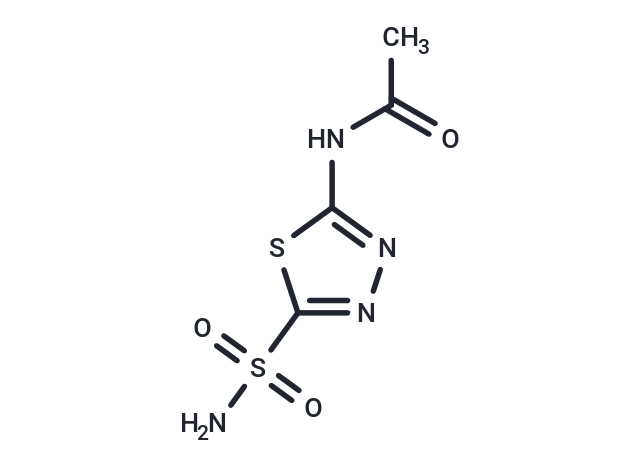Shopping Cart
- Remove All
 Your shopping cart is currently empty
Your shopping cart is currently empty

Acetazolamide (Diamox) is a Carbonic Anhydrase Inhibitor. The mechanism of action of acetazolamide is as a Carbonic Anhydrase Inhibitor. The chemical classification of acetazolamide is Sulfonamides.

| Pack Size | Price | Availability | Quantity |
|---|---|---|---|
| 100 mg | $35 | Backorder | |
| 200 mg | $42 | Backorder | |
| 500 mg | $50 | Backorder | |
| 1 g | $53 | Backorder | |
| 1 mL x 10 mM (in DMSO) | $48 | Backorder |
| Description | Acetazolamide (Diamox) is a Carbonic Anhydrase Inhibitor. The mechanism of action of acetazolamide is as a Carbonic Anhydrase Inhibitor. The chemical classification of acetazolamide is Sulfonamides. |
| Targets&IC50 | CA:10 nM |
| In vitro | acetazolamide reduces invasiveness of cancer cells in vitro[3]. |
| In vivo | Acetazolamide reduces inflammation-induced heat hyperalgesia, probably acting both peripherally and centrally[1]. Acetazolamide shows significant inhibitory effect on angiogenesis in CAM and endothelial cell proliferation[2]. Acetazolamide is clinically used to reduce intraocular pressure in glaucoma, to correct metabolic alkalosis, and to manage cerebral edema. Its treatment may also be beneficial as an adjunct to cancer chemotherapy, because it can produce additive tumor growth delays with anticancer drugs in vivo[3]. |
| Cell Research | The invasion assay is performed in a Biocoat Matrigel invasion chamber. Cells (n = 1.8 × 105) are added to the chamber and cultured for 48 h in the presence or absence of acetazolamide, which was administered twice during the 48-h period: the first dose at the beginning of the assay and the second after 24 h. After growing for 48 h, noninvasive cells are removed from the upper surface of the membrane with a cotton swab. The invasive cells on the lower surface of the membrane are fixed with 4% (vol/vol) neutral-buffered formaldehyde, stained with toluidine blue, and counted in 20 separate areas with a Leitz Diaplan microscope. (Only for Reference) |
| Alias | Diamox |
| Molecular Weight | 222.245 |
| Formula | C4H6N4O3S2 |
| Cas No. | 59-66-5 |
| Smiles | CC(=O)NC1=NN=C(S1)S(N)(=O)=O |
| Relative Density. | 1.610 g/cm3 (Estimated) |
| Storage | Powder: -20°C for 3 years | In solvent: -80°C for 1 year | Shipping with blue ice. | ||||||||||||||||||||
| Solubility Information | Ethanol: <1 mg/mL DMSO: >10 mM, Sonication is recommended. | ||||||||||||||||||||
Solution Preparation Table | |||||||||||||||||||||
DMSO
| |||||||||||||||||||||

Copyright © 2015-2025 TargetMol Chemicals Inc. All Rights Reserved.